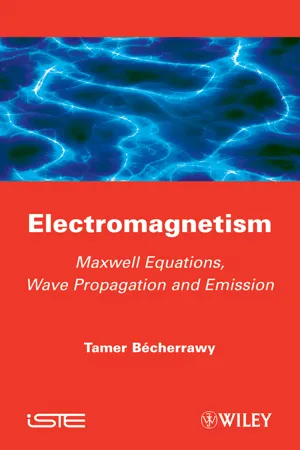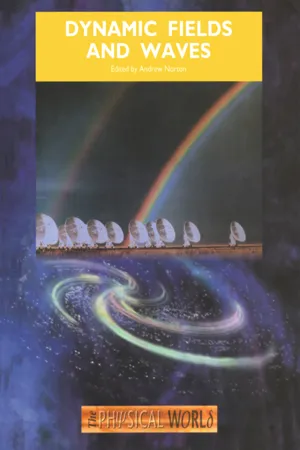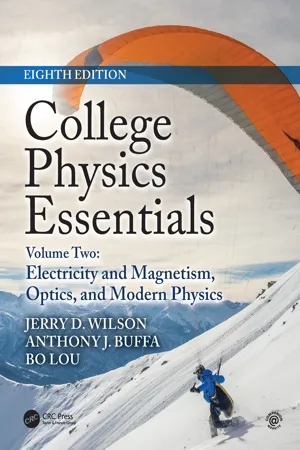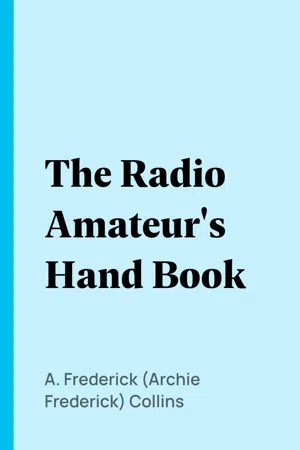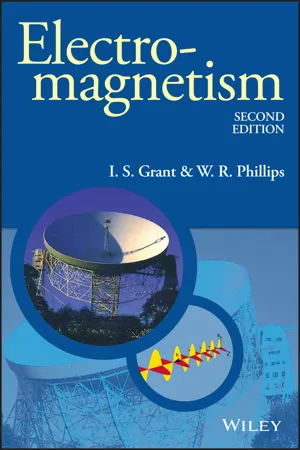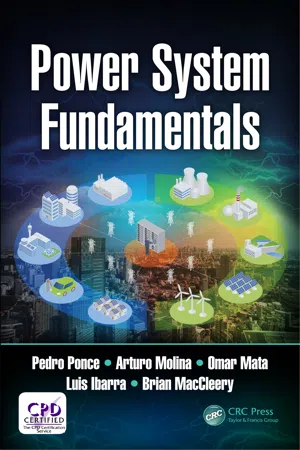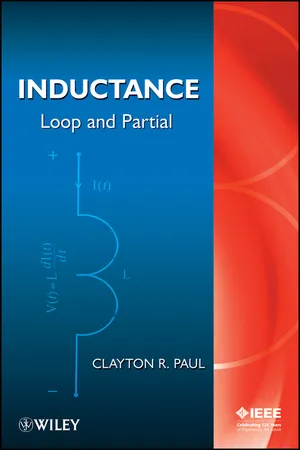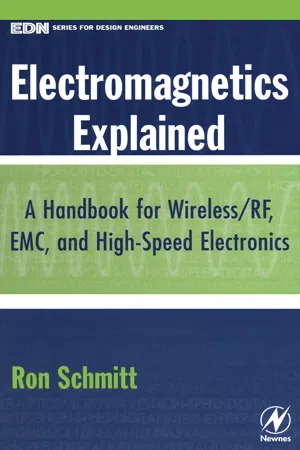Physics
Induced Currents
Induced currents refer to the production of an electric current in a conductor due to a changing magnetic field. This phenomenon is described by Faraday's law of electromagnetic induction, which states that a changing magnetic field induces an electromotive force (EMF) in a conductor, resulting in the generation of an induced current. Induced currents are fundamental to understanding the relationship between electricity and magnetism.
Written by Perlego with AI-assistance
Related key terms
Related key terms
1 of 4
Related key terms
1 of 3
12 Key excerpts on "Induced Currents"
- eBook - ePub
Electromagnetism
Maxwell Equations, Wave Propagation and Emission
- Tamer Becherrawy(Author)
- 2013(Publication Date)
- Wiley-ISTE(Publisher)
Chapter 8Induction
After the discovery in 1819 by Oersted that an electric current produces a magnetic field, scientists turned their attention to search for the inverse effect, that is, the production of an electric current by a magnetic field. In 1831, Faraday in England and Henry in the United States showed that a varying magnetic field or more generally a varying magnetic flux in a circuit induces an electric current. Faraday was the first to publish his results and the discovery of this induction law was attributed to him. Henry later discovered self-induction , i.e. the induction of an electromotive force (emf) in a circuit if its own magnetic flux varies. The discovery of induction had many important applications. One of them was the large-scale production of electricity, which led to a new technological era.The induction phenomenon is quite complicated, because there are really two kinds: Neumann's induction , which appears even in vacuum if the magnetic field varies in time, and Lorentz induction , which appears in moving conductors in a constant magnetic field. In this chapter we will study induction and some of its applications.8.1. Induction due to the variation of the flux, Faraday's and Lenz's laws
Faraday's historic experiment showed that a current is induced in a circuit (without generators) if the magnetic flux through this circuit varies. The flux may be varied by displacing a magnet or by varying the field of a nearby electromagnet by varying its current. The induced current lasts as long as the magnetic flux varies. Faraday formulated his results by stating that the induced emf in a circuit is equal to the rate of variation of the magnetic flux through this circuit . In 1834, Lenz formulated the law that the direction of the induced current is such that it opposes the cause that produces it - eBook - ePub
- A Norton(Author)
- 2019(Publication Date)
- CRC Press(Publisher)
As you have seen, no induced current will be observed in the secondary circuit if the current (and hence the magnetic field) in the primary circuit is constant. This is true whatever the constant value of the voltage supplied to the primary circuit—even if it is so great that the wire’s insulation begins to smoke, as was discovered by Faraday!To summarize, you have seen that currents are produced either by moving conducting wires through magnetic fields, or by changing the magnetic field that threads a conducting wire. The current obtained in either way is called an induced current.2.3 Magnetic flux
Think back to Question 1.1 (Figure 1.11 ). The current was generated only when a changing area of the circuit was crossing the steady field. No current flowed when the whole circuit moved within a uniform field. Somehow the loop area as well as the magnetic field is involved in the process of creating an induced current. Experiment reveals that for a loop of conducting material in a uniform magnetic field perpendicular to the loop, it is the quantity(area of loop) × (strength of the perpendicular magnetic field)which is central to the induction of currents. This quantity is a particular example of magnetic flux, and is represented by the symbol ϕ. The name ‘flux’ comes from the fact that a similar quantity is used to study the amount of fluid flowing out of a surface, and this can be used to get an intuitive mental picture of the magnetic flux. Of course a magnetic field is not a stream of fluid, but as a mental picture, an imaginary fluid streaming in the direction of the magnetic field lines is quite useful. The magnetic flux through a given area is a measure of this imaginary ‘streaming’ through that area.So far only the case in which the magnetic field is at right-angles to the surface has been considered, as shown in Figure 1.15a . But what if the magnetic field is not perpendicular to the surface? Returning to the picture of a streaming fluid, clearly any field component along the surface will not contribute to the streaming effect through the surface. So in order to determine the magnetic flux, the component of B which is perpendicular to the surface must be determined. Figure 1.15b illustrates how this can be done. In this case the magnetic field is inclined at an angle θ - eBook - ePub
College Physics Essentials, Eighth Edition
Electricity and Magnetism, Optics, Modern Physics (Volume Two)
- Jerry D. Wilson, Anthony J. Buffa, Bo Lou(Authors)
- 2019(Publication Date)
- CRC Press(Publisher)
But how does this last step take place? Regardless of the source of the energy – the burning of fossil fuels; heat from a nuclear reactor, wind, waves, or falling water – the actual conversion to electric energy is accomplished by using magnetic fields and the concept of electromagnetic induction. This chapter not only examines the underlying principles of induction, but also discusses several practical applications. Last, it will be shown that the creation and propagation of electromagnetic radiation are intimately related to electromagnetic induction.20.1 Induced emf: Faraday’s Law and Lenz’s LawRecall from Section 17.1 that the term emf stands for electromotive force, which is an electric potential difference capable of causing an electric current. It is observed experimentally that a magnet, when held stationary near a conducting wire loop, does not induce an emf (and therefore induces no current) in that loop (▲ Figure 20.1a ). If the magnet is moved toward the loop, however, as in Figure 20.1b , the deflection of the galvanometer* needle indicates that current is created in the loop, but only during the motion of the magnet. Moreover, if the magnet is then moved away from the loop, as in Figure 20.1c , the galvanometer needle deflects in the opposite direction, which indicates a reversal of the current direction but, again, this only occurs during the motion of the magnet.▲ Figure 20.1 Electromagnetic induction (a) When there is no relative motion between the magnet and the wire loop, the number of field lines through the loop (in this case, seven) is constant, and the galvanometer (see text footnote) shows no deflection, indicating no induced current. (b) However, moving the magnet toward the loop increases the number of field lines passing through the loop (now twelve), and an induced current is detected. (c) Moving the magnet away from the loop decreases the number of field lines passing through the loop (to five). The result is that the induced current is now in the opposite direction. (Note the needle deflection.)Further experiments indicate that deflection of the galvanometer needle, indicating the presence of Induced Currents , also occurs if the loop is moved toward or away from a stationary magnet. Thus the inducing effect depends on the relative motion of loop and magnet. It has also been determined that the magnitude of the induced current depends on the speed of that motion. Experimentally, there is a noteworthy exception. If a loop is moved (but not rotated) in a uniform magnetic field, as shown in ▶ Figure 20.2 - eBook - ePub
- Anupam Garg(Author)
- 2012(Publication Date)
- Princeton University Press(Publisher)
induction , and the quantitative law for it, which is named after Faraday, isFaraday’s law generalizes the ∇ × E = 0 law of electrostatics to time-dependent situations. In such situations, the electric field is not irrotational. Note, however, that Gauss’s law continues to hold unchanged.If we integrate eq. (28.1) over a surface S in space, and use Stokes’s theorem, we obtainThe line integral of E around a circuit is one instance of an electromotive force , or emf for short.1 We shall denote the emf by the symbol . Since the surface integral of B is the magnetic flux Φ passing through that surface, we can also writeIn words, the emf around a circuit is the negative rate of change of the magnetic flux passing through that circuit (divided by the speed of light in the Gaussian system). This is, in fact, the form in which Faraday first gave his law, and so stated, it is known as the flux rule. The direction of the induced emf can be deduced from eq. (28.3) but is often stated in terms of Lenz’s rule. Let us note that the induced current in a loop creates its own magnetic field. Lenz’s rule states that the direction of the induced emf around a circuit is such that the induced flux opposes the impressed change in flux. The rule is easily verified by considering a circular loop in the xy plane with a steadily increasing B field in the z direction.Let us now vary our experiment somewhat. We keep the primary (current-carrying) coil fixed and move the secondary coil instead. By the principle of relativity, we still expect to find an emf in the secondary. Indeed, just this was observed by Faraday. But the magnetic field is now time independent, so eq. (28.1) does not apply, and the induced emf must be governed by some other law. This law is the Lorentz force law. To see this, we consider yet another variant of the experiment, in which the secondary circuit is not just moved rigidly but changes its shape. We take a rectangular loop of wire with a movable arm (fig. 5.1 ), placed in a steady and uniform magnetic field perpendicular to the loop. If the movable arm is moved with a speed v , the electrons in that arm must move with it, and each of them will experience a Lorentz force −ev B/c , or v B/c - eBook - ePub
- Michael M. Mansfield, Colm O'Sullivan(Authors)
- 2020(Publication Date)
- Wiley(Publisher)
Figure 20.7 , that is perpendicular to AB and in the plane of the loop.An emf is induced in coil 1 due to the relative motion of the current carrying coil 2 or if the current in coil 2 is varied.Figure 20.6This force must be overcome to keep AB moving with velocity v and the mechanical power generated in these circumstances (recall Section 5.8 ) is given by Equation (5.19) , that isBecause of the effect of the magnetic field on the induced current flowing from A to B, the moving wire will experience a force F which must be overcome to keep the wire moving at constant speed.Figure 20.7which is exactly the same value as the thermal power given by Equation (20.4) . Thus we see that the power generated, when a current is induced in a circuit by a changing magnetic field, is at the expense of the power that is generated by the forces which must be applied to overcome the resistance to motion exerted when the induced current flows in the magnetic field. In this case, the direction of the induced emf is such that the force exerted on the induced current by the magnetic field opposes the motion of the wire AB. Similarly, when the magnet is moved relative to the coil in Figure 20.4 , the resulting current induced in the coil generates a magnetic field which exerts a force on the magnet which opposes its motion. This is a special case of a useful general rule, known as Lenz's ‘law’ - eBook - ePub
The Radio Amateur's Hand Book
A Complete, Authentic and Informative Work on Wireless Telegraphy and Telephony
- A. Frederick (Archie Frederick) Collins(Author)
- 2004(Publication Date)
- Perlego(Publisher)
Conversely, when a magnetic line of force is set up a part of its energy goes to make up electric currents which whirl about in a like manner, as shown at B. (A) and (B) Fig. 32.--How an Electric Current is Changed into Magnetic Lines of Force and These into an Electric Current. (C) and (D) Fig. 32.--How an Electric Current Sets up a Magnetic Field. Self-induction or Inductance.--When a current is made to flow in a coil of wire the magnetic lines of force produced are concentrated, as at C, just as a lens concentrates rays of light, and this forms an intense magnetic field, as it is called. Now if a bar of soft iron is brought close to one end of the coil of wire, or, better still, if it is pushed into the coil, it will be magnetized by electromagnetic induction, see D, and it will remain a magnet until the current is cut off. Mutual Induction.--When two loops of wire, or better, two coils of wire, are placed close together the electromagnetic induction between them is reactive, that is, when a current is made to flow through one of the coils closed magnetic lines of force are set up and when these cut the other loop or turns of wire of the other coil, they in turn produce electric currents in it. It is the mutual induction that takes place between two coils of wire which makes it possible to transform low voltage currents from a battery or a 110 volt source of current into high pressure currents, or high potential currents, as they are called, by means of a spark coil or a transformer, as well as to step up and step down the potential of the high frequency currents that are set up in sending and receiving oscillation transformers - eBook - ePub
- Adrian Waygood(Author)
- 2018(Publication Date)
- Routledge(Publisher)
Chapter 19 Electromagnetic inductionObjectives
On completion of this chapter, you should be able to- explain the result of moving a permanent magnet towards, or away from, a coil.
- describe the effect of moving a straight conductor perpendicularly through a magnetic field.
- determine the magnitude and direction of the potential difference induced into a straight conductor moved perpendicularly through a magnetic field.
- demonstrate the application of Fleming’s Right-Hand Rule for generator action.
- briefly explain the effects of self-induction.
- explain Faraday’s and Lenz’s Laws for electromagnetic induction.
- list the factors that affect the self-induction of a coil.
- describe the effect of self-induction on the growth and decay of direct currents in inductive circuits.
- solve simple problems on the growth and decay of direct currents in inductive circuits.
- explain the terms ‘mutual inductance’ and ‘coupled circuits’.
- describe the behaviour of the mutual induction between two inductive circuits.
- solve simple problems on mutual induction.
- describe how energy is stored in magnetic fields.
- solve simple problems on the energy stored in magnetic fields.
- recognise and give simple examples of the functions of inductors.
- solve simple problems on inductors in series and in parallel.
Important ! Conventional current (positive to negative) is assumed throughout this chapter.Introduction
One of the most important advances in the science of electrical engineering was made in 1831, when Sir Michael Faraday (1791–1867) discovered that whenever there is relative motion between lines of magnetic flux and a conductor, a potential difference is ‘induced’ into the conductor.So, as predicted by scientists such as Ørsted, it was indeed possible to use movement to produce electricity!We call this behaviour electromagnetic induction and, within a year of Faraday’s discovery, it was discovered quite independently by the American physicist Joseph Henry - eBook - ePub
- I. S. Grant, W. R. Phillips(Authors)
- 2013(Publication Date)
- Wiley(Publisher)
CHAPTER 4
Steady currents and magnetic fields
The previous chapters were concerned with the forces between stationary charges and their description in terms of the electrostatic field and potential. We now consider what happens when charges are in motion. As well as the force represented by the electric field, a moving charge may experience an additional force, called a magnetic force, when it is in the presence of other moving charges or permanent magnets. Magnetic forces are also conveniently described in terms of a vector field—the magnetic field—from which we can derive the force on a moving charge at any point.A steady electric current in a conducting wire arises from the continuous motion of charge along the wire, and a moving charge near a current-carrying wire may therefore experience a magnetic force. In this chapter we shall first explain the rules governing the flow of current in conductors, and then go on to discuss the magnetic fields caused by steady currents in conductors.4.1 ELECTROMOTIVE FORCE AND CONDUCTION
4.1.1 Current and resistance
Some of the electrons inside conductors are not bound to particular atoms but are free to move from atom to atom. In a metal we may picture these free electrons, the conduction electrons, as behaving more or less like gas molecules in a box, moving about at random with large speeds, and colliding with atoms in the metallic lattice. In the absence of an applied electric field the mean electron velocity, averaged over any volume which is very large on a microscopic scale, will be zero. If an electric field E is maintained in the conductor the electrons acquire an average velocity v in the direction opposite to the field. This is because, between collisions with atoms in the conductor, the electrons are acted upon by a force – e E. The mean drift velocity v - eBook - ePub
- Pedro Ponce, Arturo Molina, Omar Mata, Luis Ibarra, Brian MacCleery(Authors)
- 2017(Publication Date)
- CRC Press(Publisher)
61 ]:- The strength of the magnetic field decreases or increases
- The angle between and the surface normal changesB →
- The area of the surface S changes
FIGURE 2.2 Lenz law defines the direction of the current.(2.16)∮ CE →· p= -dl→ddt∫ SB →· pn ^d a ,where the electric field is expressed bythat is a vector, and the increment segment of the path C isE →.dl→The sign of the right-hand side of Faraday’s law is defined by the Lenz law according to Figure 2.2 . The EMF is produced when the magnetic flux is changing, so a current is generated. This current generates a magnetic field opposing the flux change that produced it. The Lenz law can be defined using the energy conservation principle because the direction of the current opposes the change. When the change appears, the current appears to limit it. Thus, the current avoids an increment of the change that induces a bigger current that increases the change.An electrical charge in motion experiences a force when an electromagnetic field is an area of influence of this electromagnetic field. The Lorentz equation is defined by (2.17 ) in which the force direction and magnitude are described by the cross-product [61 ].(2.17)F = q u × B ,where F is the force [N], Q is the value of the electric charge [C], u is the velocity of the charge [m/s], and B is the magnetic flux density [T].If it is supposed that a current of magnitudeflows in a conductor of length l within a uniform magnetic field, it is possible to rewrite Equation (2.17 ) and get Equation (1.7 )I(2.18)F = l I × B .A wire experiences a force when a current is flowing through it and an external magnetic field is acting across that current flow. The force is perpendicular to the magnetic field and the current as it is shown in Figure 2.3 , which depicts Fleming’s left-hand rule [61 - eBook - ePub
Inductance
Loop and Partial
- Clayton R. Paul(Author)
- 2011(Publication Date)
- Wiley-IEEE Press(Publisher)
In the remaining chapters we discuss the computation of the inductance of a closed loop that is constructed of a conductor such as a wire or a land on a printed circuit board. This final section will serve as a preliminary to those discussions.Faraday’s fundamental law of induction indicates that an electromotive force is induced in the perimeter of any closed loop through the enclosed surface of which a time-varying magnetic field passes. We have represented that emf in Fig. 3.2 as a lumped voltage source placed at an indeterminate position in the loop:(3.45)This voltage source represents the time rate of change of the total magnetic flux penetrating that loop:(3.46)We can also write the flux through the loop in an equivalent form in terms of the line integral of the vector magnetic potential A around the loop using the identity B = ∇ × A. Hence, the magnetic flux through the loop can be written as a line integral of A around that loop as(3.47)where we have used Stokes’s theorem (see the Appendix) to convert a surface integral over the open surface s enclosed by the conducting loop into a line integral around the contour c enclosing the surface. Hence, Faraday’s fundamental law of induction can be written in two alternative forms as(3.48)FIGURE 3.10 . Conducting loop with a small gap.Consider a conducting loop composed of a perfect conductor that has a very small gap cut in it, as shown in Fig. 3.10 . Along the conductor of the loop E = 0, so that Faraday’s law gives(3.49)But the electric field along the perfect conductor is zero, giving(3.50)Moving the minus sign to the left-hand side gives(3.51)Hence, a voltage that is related to the time rate of change of the magnetic flux appears at the terminals of the open-circuited loop. Essentially, the timechanging magnetic flux through the loop induces an electric field in the conductor that forces the charges (electrons) in the conductor to move to the terminals of the gap, thereby creating another electric field due to this electric field across the gap induced by the charge that is accumulated at the terminals. The sum of this induced electric field caused by the charges at the gap and the original electric field combine to give a net electric field that is zero on the surface of the conductor, therby satisfying the boundary conditions that the tangential electric field on the surface of a perfect conductor must equal zero. - eBook - ePub
Electromagnetics Explained
A Handbook for Wireless/ RF, EMC, and High-Speed Electronics
- Ron Schmitt(Author)
- 2002(Publication Date)
- Newnes(Publisher)
(The DC magnetic field can be supplied by permanent magnets or by an electromagnet.) With a DC field applied, ferrites become anisotropic; that is, their magnetic properties are different in different directions. Simply stated, the DC field causes the ferrite to be saturated in the direction of the field while remaining unsaturated in the other two directions. Voltage-controlled phase-shifters and filters as well as exotic directional devices such as gyrators, isolators, and circulators can be created with ferrites in the microwave region. MAXWELL’S EQUATIONS AND THE DISPLACEMENT CURRENT In the 1860s, the British physicist James Clerk Maxwell set himself to the task of completely and concisely writing all the known laws of electricity and magnetism. During this exercise, Maxwell noticed a mathematical inconsistency in Ampere’s law. Recall that Ampere’s law predicts that a magnetic field surrounds all electric currents. To fix the problem, Maxwell proposed that not only do electric currents, the movement of charge, produce magnetic fields, but changing electric fields also produce magnetic fields. In other words, you do not necessarily need a charge to produce a magnetic field. For instance, when a capacitor is charging, there exists a changing electric field between the two plates. When an AC voltage is applied to a capacitor, the constant charging and discharging leads to current going to and from the plates. As I discussed in Chapter 1, although no current ever travels between the plates, the storing of opposite charges on the plates gives the perceived effect of a current traveling through the capacitor. This virtual current is called displacement current, named so because the virtual current arises from the displacement of charge at the plates - eBook - ePub
- David Wyatt, Mike Tooley(Authors)
- 2018(Publication Date)
- Routledge(Publisher)
transformer, which we shall meet later.Figure 1.31 Mutual inductanceFigure 1.32 A real inductor has resistance as well as inductance1.6.4 Inductors
Inductors provide us with a means of storing electrical energy in the form of a magnetic field. Typical applications include chokes, filters, and frequency selective circuits. The electrical characteristics of an inductor are determined by a number of factors including the material of the core (if any), the number of turns, and the physical dimensions of the coil.In practice every coil comprises both inductance and resistance and the circuit of Fig. 1.32 shows these as two discrete components. In reality the inductance, L , and resistance, R , are both distributed throughout the component but it is convenient to treat the inductance and resistance as separate components in the analysis of the circuit.Key point An e.m.f. is produced when the magnetic flux passing through an inductor changes.Figure 1.33 A selection of inductors with values ranging from 100 nH to 4H and current ratings ranging from 0.1 A to 10 AKey point The current induced in a conductor always opposes the change that produces it.Test your understanding 1.8- A 1.5 m length of wire moves perpendicular to a magnetic flux field of 0.75 T. Determine the e.m.f. that will be induced across the ends of the wire if it moves at 10m/s.
- An e.m.f. of 30V is developed across the terminals of an inductor when the current flowing in it changes from zero to 10 A in half a second. What is the value of inductance?
1.7 Alternating current and transformers
Direct currents are currents which, even though their magnitude may vary, essentially flow only in one direction. In other words, direct currents are unidirectional. Alternating currents, on the other hand, are bi-directional and continuously reversing their direction of flow, as shown in Fig. 1.34
Index pages curate the most relevant extracts from our library of academic textbooks. They’ve been created using an in-house natural language model (NLM), each adding context and meaning to key research topics.
Explore more topic indexes
Explore more topic indexes
1 of 6
Explore more topic indexes
1 of 4
